tow TOYOTA YARIS HYBRID 2016 Owners Manual
[x] Cancel search | Manufacturer: TOYOTA, Model Year: 2016, Model line: YARIS HYBRID, Model: TOYOTA YARIS HYBRID 2016Pages: 492, PDF Size: 31.95 MB
Page 3 of 492
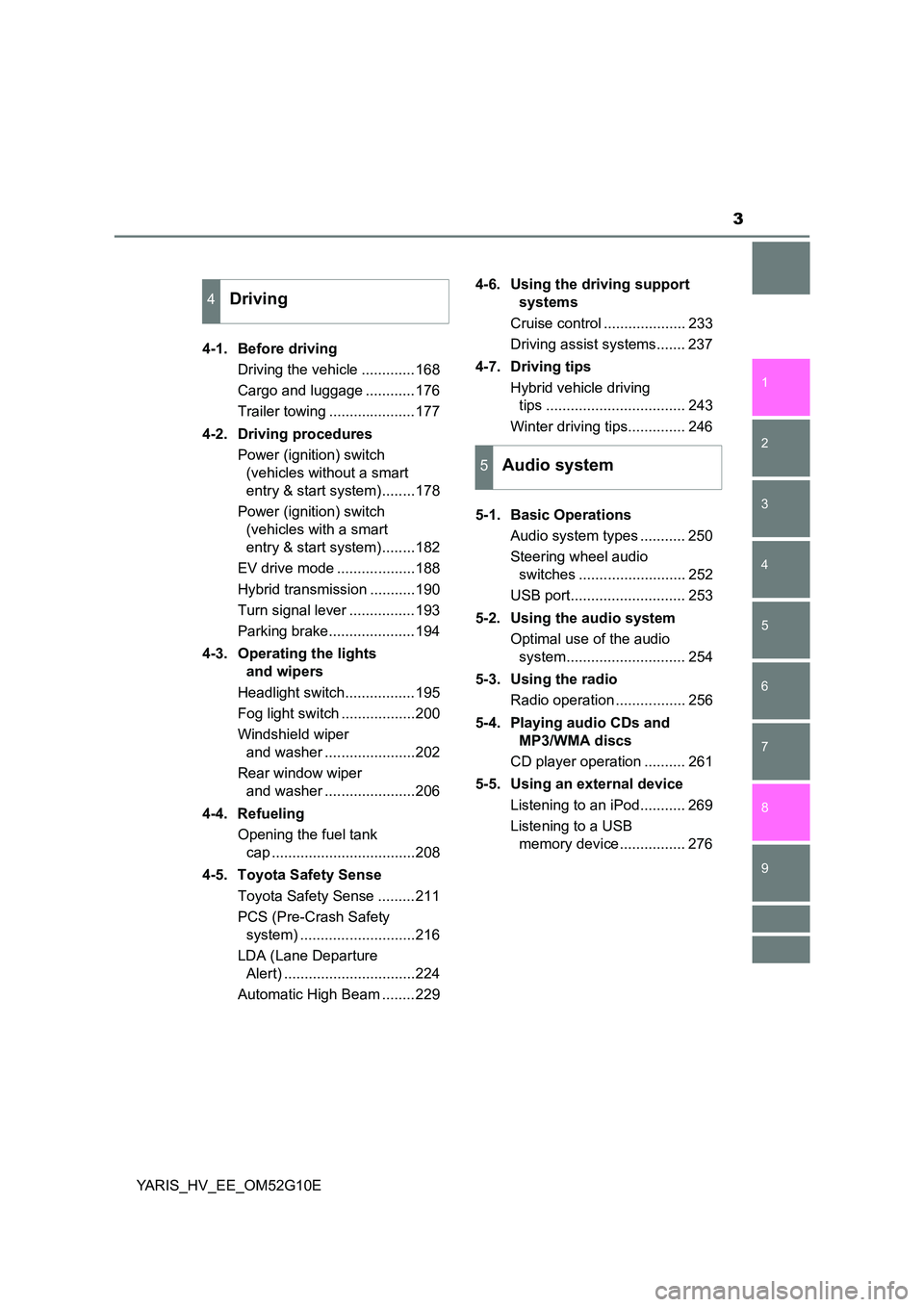
3
1
7
8
6
5
4
3
2
9
YARIS_HV_EE_OM52G10E
4-1. Before driving
Driving the vehicle .............168
Cargo and luggage ............176
Trailer towing .....................177
4-2. Driving procedures
Power (ignition) switch
(vehicles without a smart
entry & start system)........178
Power (ignition) switch
(vehicles with a smart
entry & start system)........182
EV drive mode ...................188
Hybrid transmission ...........190
Turn signal lever ................193
Parking brake.....................194
4-3. Operating the lights
and wipers
Headlight switch.................195
Fog light switch ..................200
Windshield wiper
and washer ......................202
Rear window wiper
and washer ......................206
4-4. Refueling
Opening the fuel tank
cap ...................................208
4-5. Toyota Safety Sense
Toyota Safety Sense .........211
PCS (Pre-Crash Safety
system) ............................216
LDA (Lane Departure
Alert) ................................224
Automatic High Beam ........229
4-6. Using the driving support
systems
Cruise control .................... 233
Driving assist systems....... 237
4-7. Driving tips
Hybrid vehicle driving
tips .................................. 243
Winter driving tips.............. 246
5-1. Basic Operations
Audio system types ........... 250
Steering wheel audio
switches .......................... 252
USB port............................ 253
5-2. Using the audio system
Optimal use of the audio
system............................. 254
5-3. Using the radio
Radio operation ................. 256
5-4. Playing audio CDs and
MP3/WMA discs
CD player operation .......... 261
5-5. Using an external device
Listening to an iPod........... 269
Listening to a USB
memory device ................ 276
4Driving
5Audio system
Page 5 of 492
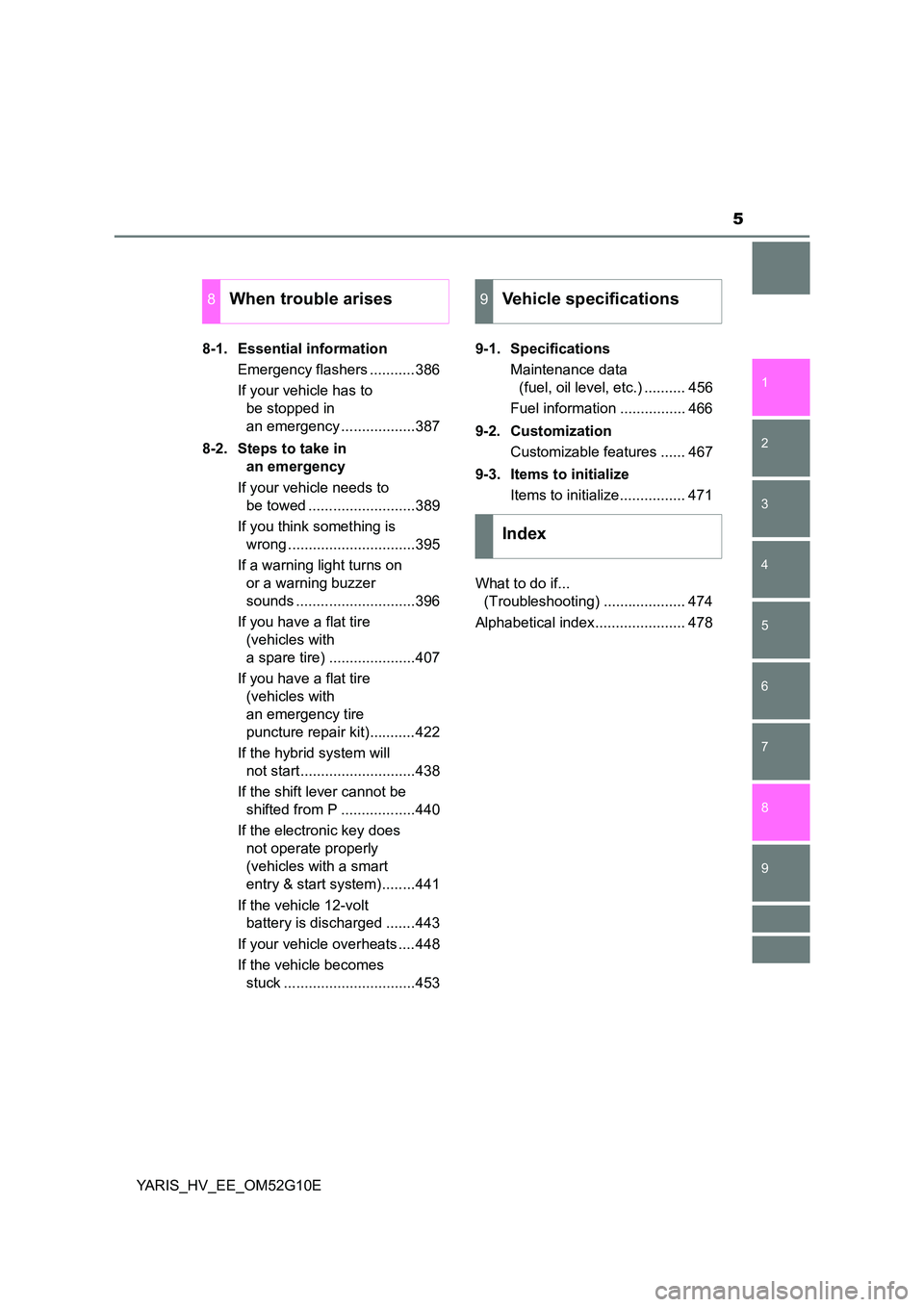
5
1
7
8
6
5
4
3
2
9
YARIS_HV_EE_OM52G10E
8-1. Essential information
Emergency flashers ...........386
If your vehicle has to
be stopped in
an emergency ..................387
8-2. Steps to take in
an emergency
If your vehicle needs to
be towed ..........................389
If you think something is
wrong ...............................395
If a warning light turns on
or a warning buzzer
sounds .............................396
If you have a flat tire
(vehicles with
a spare tire) .....................407
If you have a flat tire
(vehicles with
an emergency tire
puncture repair kit)...........422
If the hybrid system will
not start............................438
If the shift lever cannot be
shifted from P ..................440
If the electronic key does
not operate properly
(vehicles with a smart
entry & start system)........441
If the vehicle 12-volt
battery is discharged .......443
If your vehicle overheats ....448
If the vehicle becomes
stuck ................................453
9-1. Specifications
Maintenance data
(fuel, oil level, etc.) .......... 456
Fuel information ................ 466
9-2. Customization
Customizable features ...... 467
9-3. Items to initialize
Items to initialize................ 471
What to do if...
(Troubleshooting) .................... 474
Alphabetical index...................... 478
8When trouble arises9Vehicle specifications
Index
Page 14 of 492
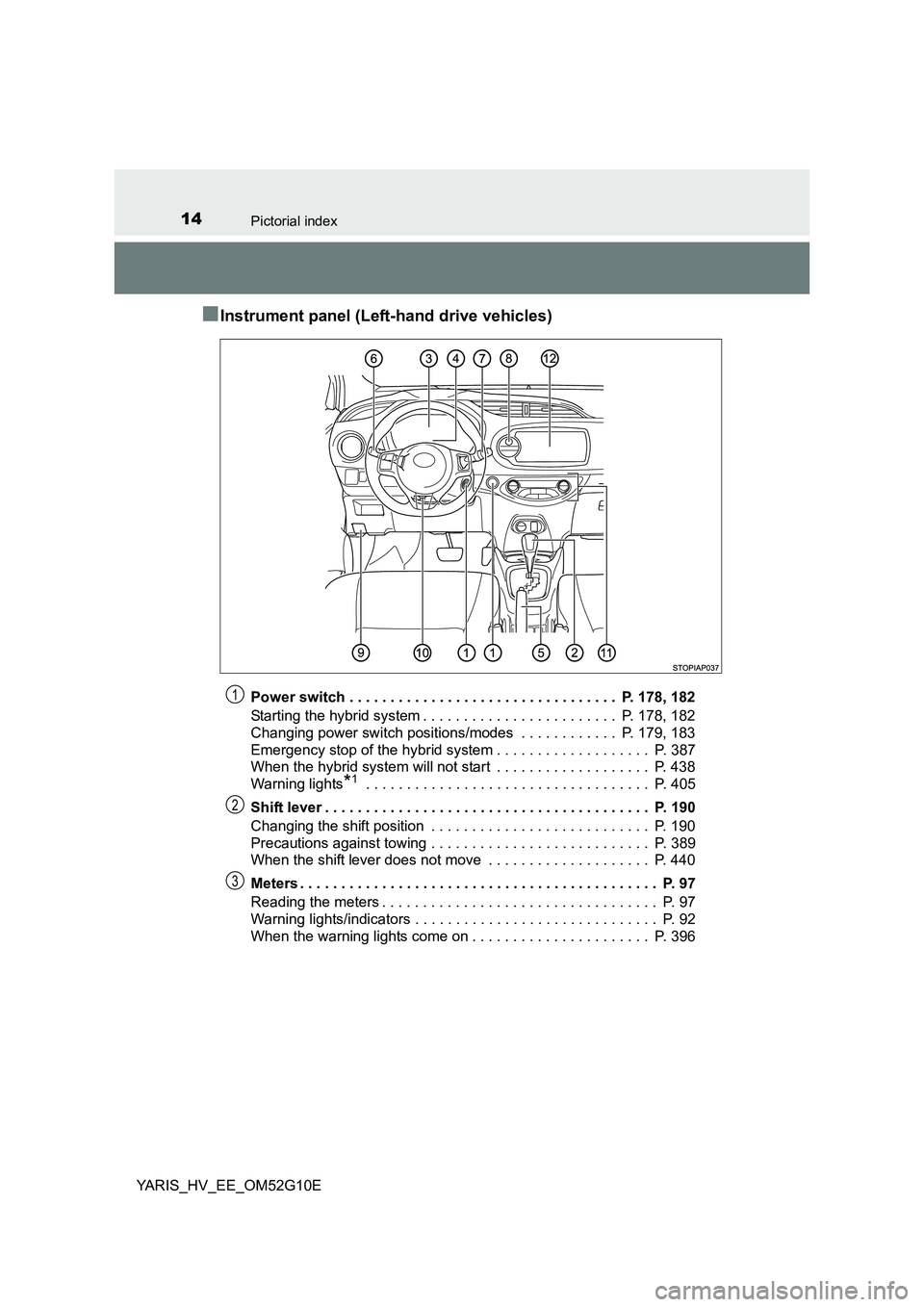
14Pictorial index
YARIS_HV_EE_OM52G10E
■Instrument panel (Left-hand drive vehicles)
Power switch . . . . . . . . . . . . . . . . . . . . . . . . . . . . . . . . . P. 178, 182
Starting the hybrid system . . . . . . . . . . . . . . . . . . . . . . . . P. 178, 182
Changing power switch positions/modes . . . . . . . . . . . . P. 179, 183
Emergency stop of the hybrid system . . . . . . . . . . . . . . . . . . . P. 387
When the hybrid system will not start . . . . . . . . . . . . . . . . . . . P. 438
Warning lights*1 . . . . . . . . . . . . . . . . . . . . . . . . . . . . . . . . . . . P. 405
Shift lever . . . . . . . . . . . . . . . . . . . . . . . . . . . . . . . . . . . . . . . . P. 190
Changing the shift position . . . . . . . . . . . . . . . . . . . . . . . . . . . P. 190
Precautions against towing . . . . . . . . . . . . . . . . . . . . . . . . . . . P. 389
When the shift lever does not move . . . . . . . . . . . . . . . . . . . . P. 440
Meters . . . . . . . . . . . . . . . . . . . . . . . . . . . . . . . . . . . . . . . . . . . . P. 97
Reading the meters . . . . . . . . . . . . . . . . . . . . . . . . . . . . . . . . . . P. 97
Warning lights/indicators . . . . . . . . . . . . . . . . . . . . . . . . . . . . . . P. 92
When the warning lights come on . . . . . . . . . . . . . . . . . . . . . . P. 396
1
2
3
Page 21 of 492
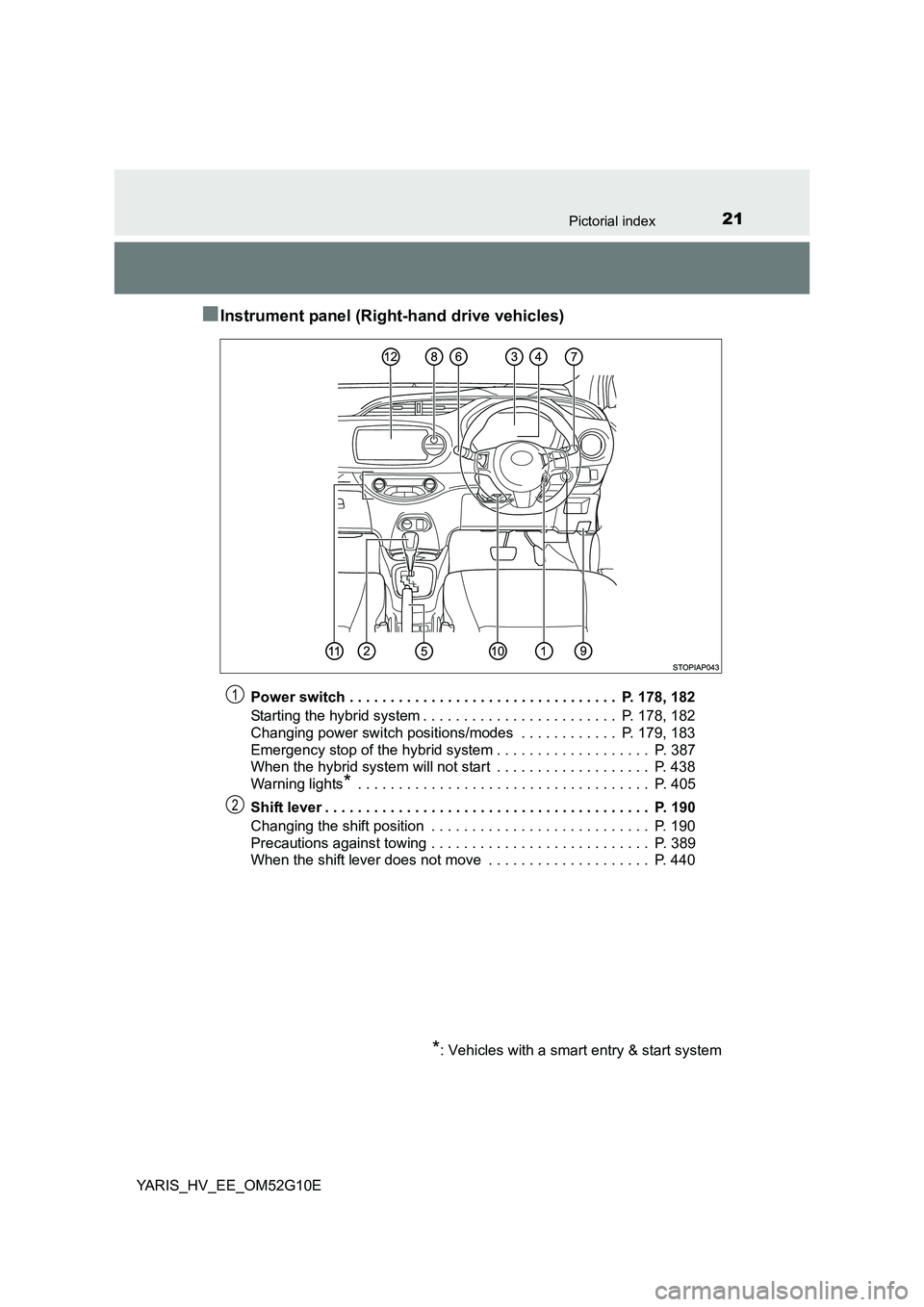
21Pictorial index
YARIS_HV_EE_OM52G10E
■Instrument panel (Right-hand drive vehicles)
Power switch . . . . . . . . . . . . . . . . . . . . . . . . . . . . . . . . . P. 178, 182
Starting the hybrid system . . . . . . . . . . . . . . . . . . . . . . . . P. 178, 182
Changing power switch positions/modes . . . . . . . . . . . . P. 179, 183
Emergency stop of the hybrid system . . . . . . . . . . . . . . . . . . . P. 387
When the hybrid system will not start . . . . . . . . . . . . . . . . . . . P. 438
Warning lights* . . . . . . . . . . . . . . . . . . . . . . . . . . . . . . . . . . . . P. 405
Shift lever . . . . . . . . . . . . . . . . . . . . . . . . . . . . . . . . . . . . . . . . P. 190
Changing the shift position . . . . . . . . . . . . . . . . . . . . . . . . . . . P. 190
Precautions against towing . . . . . . . . . . . . . . . . . . . . . . . . . . . P. 389
When the shift lever does not move . . . . . . . . . . . . . . . . . . . . P. 440
*: Vehicles with a smart entry & start system
1
2
Page 36 of 492
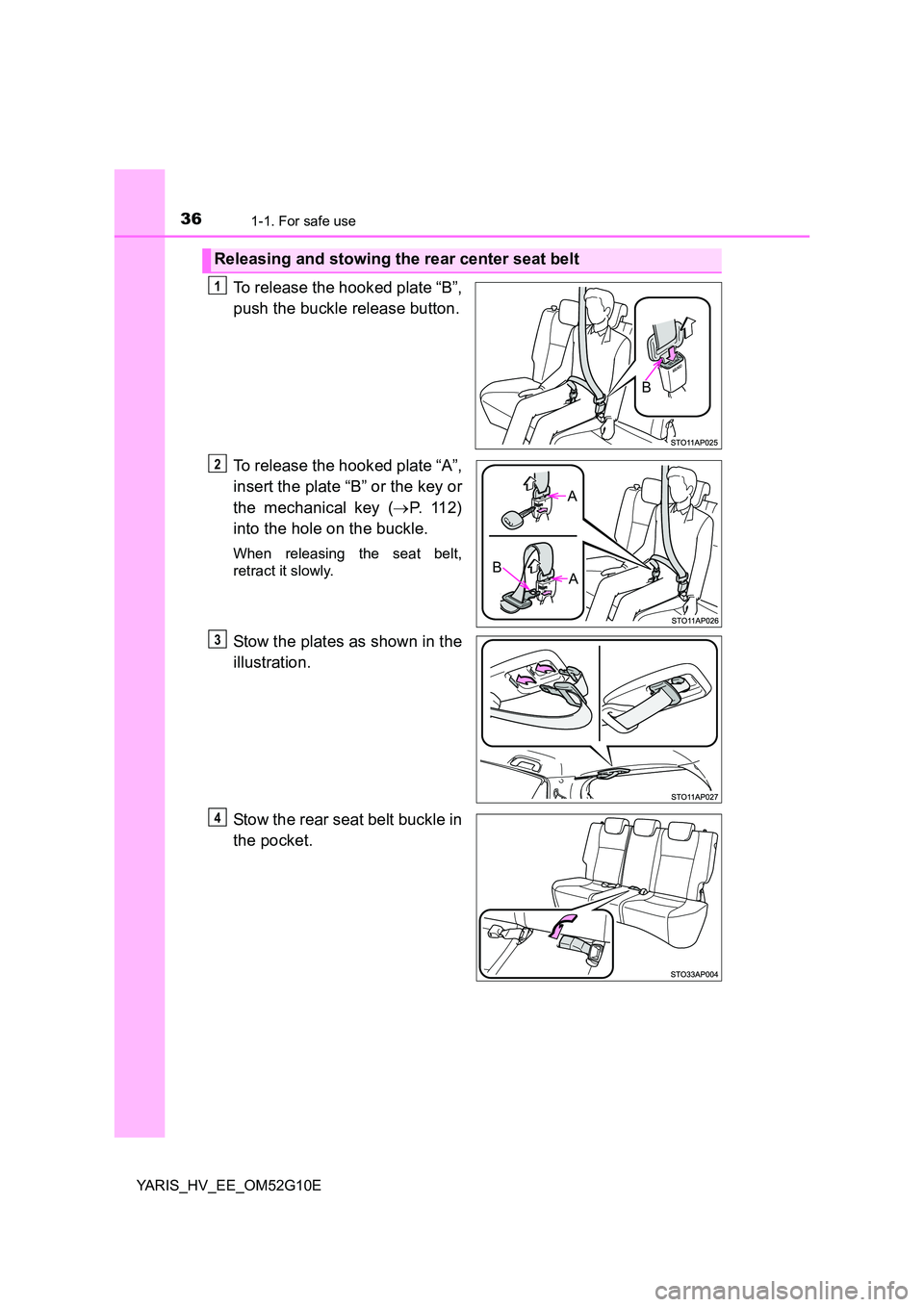
361-1. For safe use
YARIS_HV_EE_OM52G10E
To release the hooked plate “B”,
push the buckle release button.
To release the hooked plate “A”,
insert the plate “B” or the key or
the mechanical key ( P. 112)
into the hole on the buckle.
When releasing the seat belt,
retract it slowly.
Stow the plates as shown in the
illustration.
Stow the rear seat belt buckle in
the pocket.
Releasing and stowing the rear center seat belt
B
1
B
A
A
2
3
4
Page 43 of 492

431-1. For safe use
1
For safety and security
YARIS_HV_EE_OM52G10E
WARNING
■SRS airbag precautions
Observe the following precautions regarding the SRS airbags.
Failure to do so may cause death or serious injury.
● The driver and all passengers in the vehicle must wear their seat belts
properly.
The SRS airbags are supplemental devices to be used with the seat belts.
● The SRS driver airbag deploys with considerable force, and can cause
death or serious injury especially if the driver is very close to the airbag.
Since the risk zone for the driver’s airbag is the first 50 - 75 mm (2 - 3 in.)
of inflation, placing yourself 250 mm ( 10 in.) from your driver airbag pro-
vides you with a clear margin of safety. This distance is measured from
the center of the steering wheel to your breastbone. If you sit less than
250 mm (10 in.) away now, you can change your driving position in sev-
eral ways:
• Move your seat to the rear as far as you can while still reaching the ped-
als comfortably.
• Slightly recline the back of the seat. Although vehicle designs vary,
many drivers can achieve the 250 mm (10 in.) distance, even with the
driver seat all the way forward, simply by reclining the back of the seat
somewhat. If reclining the back of your seat makes it hard to see the
road, raise yourself by using a firm, non-slippery cushion, or raise the
seat if your vehicle has that feature.
• If your steering wheel is adjustable, tilt it downward. This points the
airbag toward your chest instead of your head and neck.
The seat should be adjusted as recommended above, while still maintain-
ing control of the foot pedals, steering wheel, and your view of the instru-
ment panel controls.
● The SRS front passenger airbag also deploys with considerable force, and
can cause death or serious injury especially if the front passenger is very
close to the airbag. The front passenger seat should be as far from the
airbag as possible with the seatback adjusted, so the front passenger sits
upright.
● Improperly seated and/or restrained infants and children can be killed or
seriously injured by a deploying airbag. An infant or child who is too small
to use a seat belt should be properly secured using a child restraint sys-
tem. Toyota strongly recommends that all infants and children be placed in
the rear seats of the vehicle and proper ly restrained. The rear seats are
safer for infants and children than the front passenger seat. ( P. 55)
Page 44 of 492

441-1. For safe use
YARIS_HV_EE_OM52G10E
WARNING
■SRS airbag precautions
●Do not sit on the edge of the seat or
lean against the dashboard.
● Do not allow a child to stand in front of
the SRS front passenger airbag unit or
sit on the knees of a front passenger.
● Do not allow the front seat occupants to
hold items on their knees.
● Vehicles without an SRS curtain shield
airbags: Do not lean against the front
door.
● Vehicles with an SRS curtain shield
airbags: Do not lean against the door,
the roof side rail or the front, side and
rear pillars.
● Do not allow anyone to kneel on the
passenger seat toward the door or put
their head or hands outside the vehicle.
Page 82 of 492
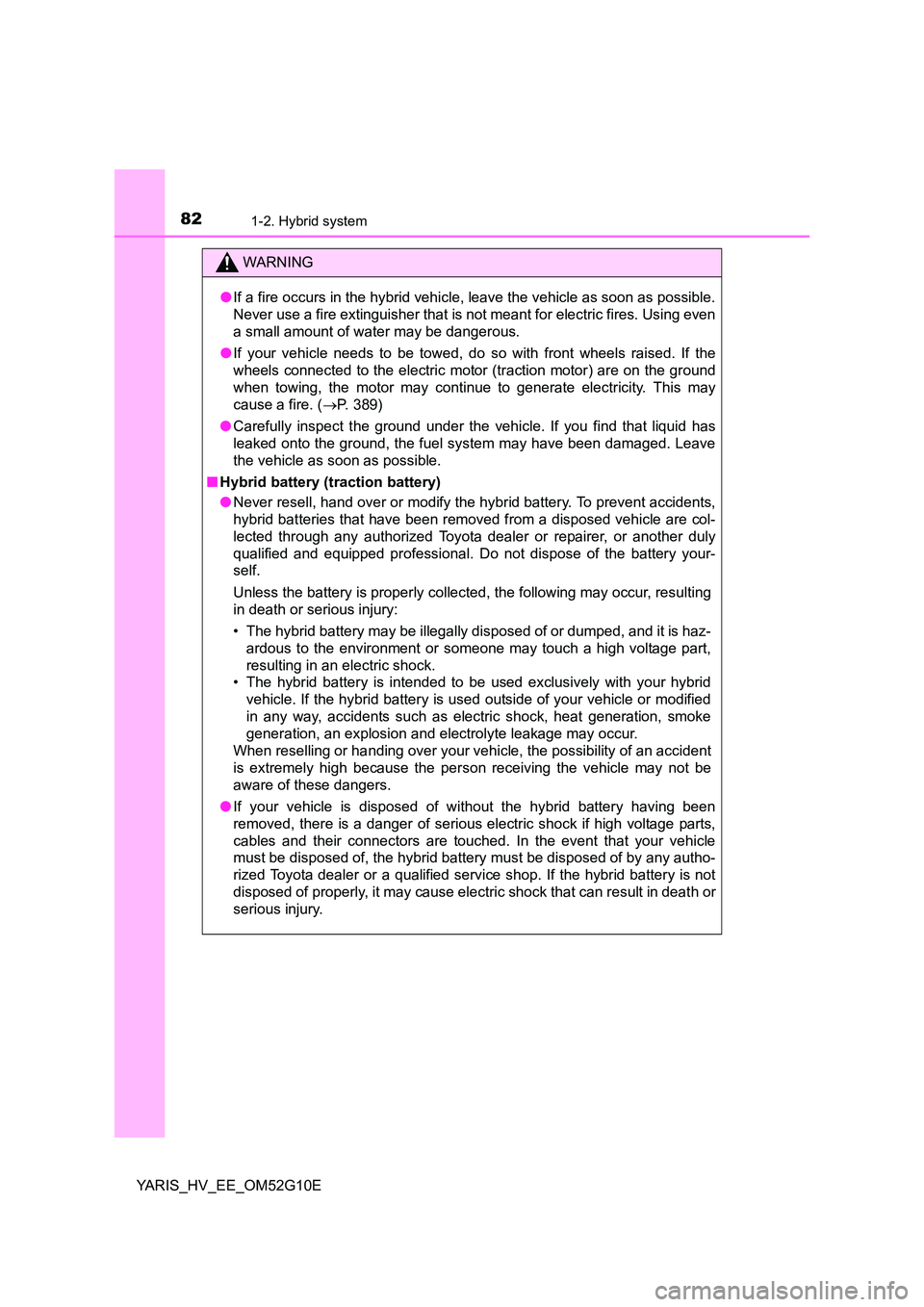
821-2. Hybrid system
YARIS_HV_EE_OM52G10E
WARNING
●If a fire occurs in the hybrid vehicle, leave the vehicle as soon as possible.
Never use a fire extinguisher that is not meant for electric fires. Using even
a small amount of water may be dangerous.
● If your vehicle needs to be towed, do so with front wheels raised. If the
wheels connected to the electric motor (traction motor) are on the ground
when towing, the motor may continue to generate electricity. This may
cause a fire. ( P. 389)
● Carefully inspect the ground under the vehicle. If you find that liquid has
leaked onto the ground, the fuel system may have been damaged. Leave
the vehicle as soon as possible.
■ Hybrid battery (traction battery)
● Never resell, hand over or modify the hybrid battery. To prevent accidents,
hybrid batteries that have been removed from a disposed vehicle are col-
lected through any authorized Toyota dealer or repairer, or another duly
qualified and equipped professional. Do not dispose of the battery your-
self.
Unless the battery is properly collected, the following may occur, resulting
in death or serious injury:
• The hybrid battery may be illegally disposed of or dumped, and it is haz-
ardous to the environment or someone may touch a high voltage part,
resulting in an electric shock.
• The hybrid battery is intended to be used exclusively with your hybrid
vehicle. If the hybrid battery is used outside of your vehicle or modified
in any way, accidents such as electric shock, heat generation, smoke
generation, an explosion and electrolyte leakage may occur.
When reselling or handing over your vehicle, the possibility of an accident
is extremely high because the person receiving the vehicle may not be
aware of these dangers.
● If your vehicle is disposed of without the hybrid battery having been
removed, there is a danger of serious electric shock if high voltage parts,
cables and their connectors are touched. In the event that your vehicle
must be disposed of, the hybrid battery must be disposed of by any autho-
rized Toyota dealer or a qualified service shop. If the hybrid battery is not
disposed of properly, it may cause electric shock that can result in death or
serious injury.
Page 112 of 492
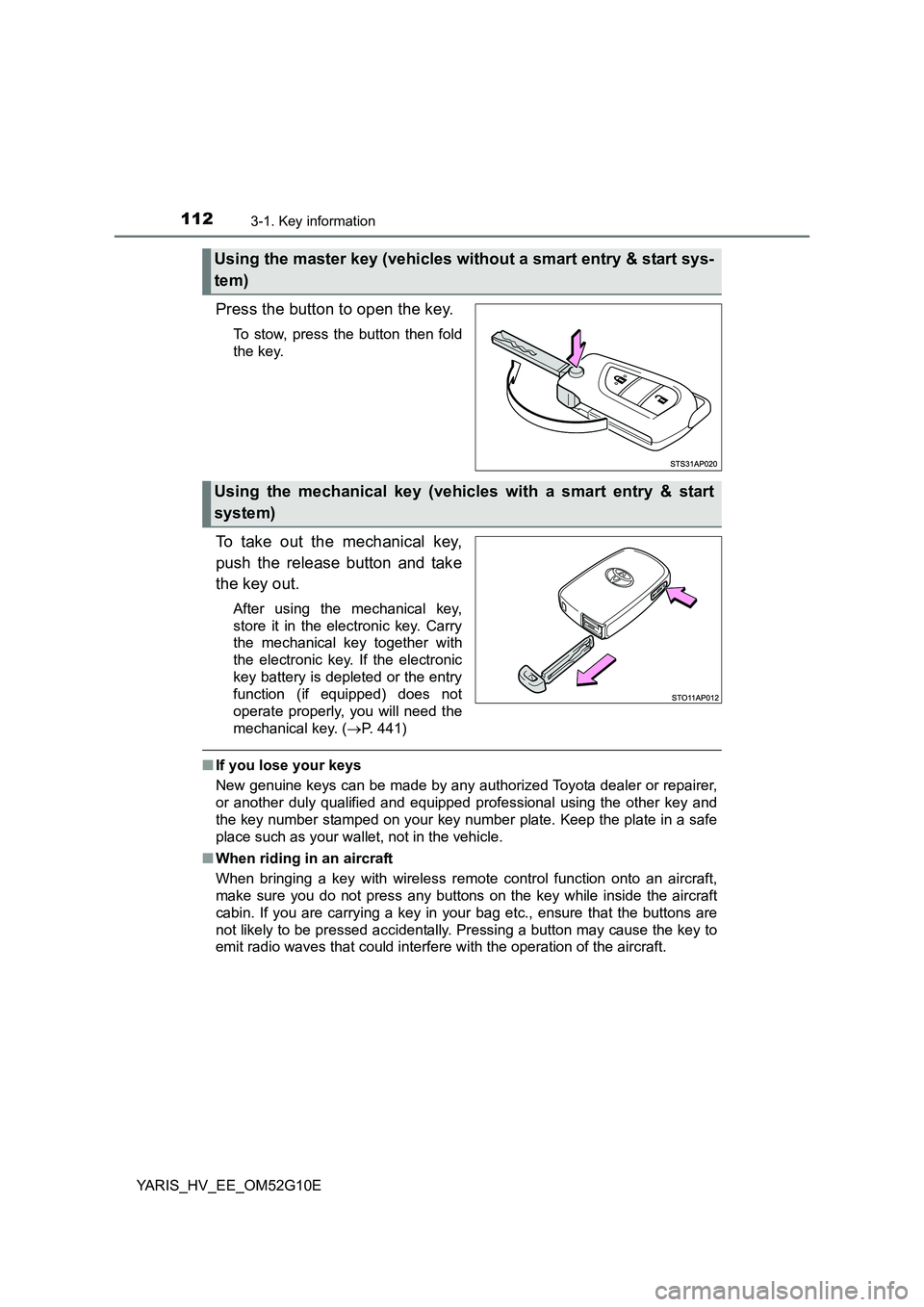
1123-1. Key information
YARIS_HV_EE_OM52G10E
Press the button to open the key.
To stow, press the button then fold
the key.
To take out the mechanical key,
push the release button and take
the key out.
After using the mechanical key,
store it in the electronic key. Carry
the mechanical key together with
the electronic key. If the electronic
key battery is depleted or the entry
function (if equipped) does not
operate properly, you will need the
mechanical key. ( P. 441)
■If you lose your keys
New genuine keys can be made by any authorized Toyota dealer or repairer,
or another duly qualified and equipped professional using the other key and
the key number stamped on your key number plate. Keep the plate in a safe
place such as your wallet, not in the vehicle.
■ When riding in an aircraft
When bringing a key with wireless remo te control function onto an aircraft,
make sure you do not press any buttons on the key while inside the aircraft
cabin. If you are carrying a key in your bag etc., ensure that the buttons are
not likely to be pressed accidentally. Pressing a button may cause the key to
emit radio waves that could interfere with the operation of the aircraft.
Using the master key (vehicles without a smart entry & start sys-
tem)
Using the mechanical key (vehicles with a smart entry & start
system)
Page 113 of 492
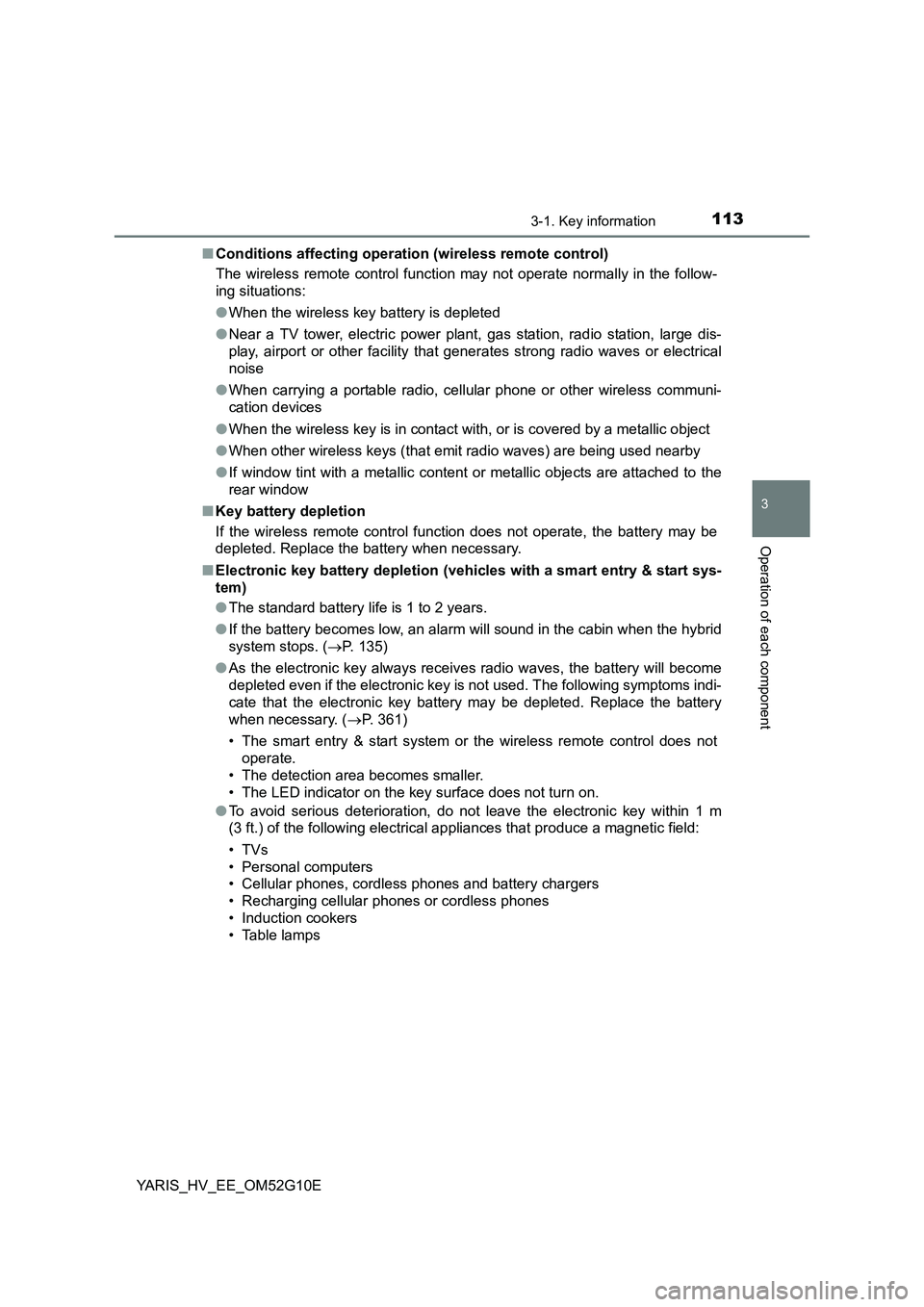
1133-1. Key information
3
Operation of each component
YARIS_HV_EE_OM52G10E
■ Conditions affecting operation (wireless remote control)
The wireless remote control function may not operate normally in the follow-
ing situations:
● When the wireless key battery is depleted
● Near a TV tower, electric power plant, gas station, radio station, large dis-
play, airport or other facility that generates strong radio waves or electrical
noise
● When carrying a portable radio, cellular phone or other wireless communi-
cation devices
● When the wireless key is in contact with, or is covered by a metallic object
● When other wireless keys (that emit radio waves) are being used nearby
● If window tint with a metallic content or metallic objects are attached to the
rear window
■ Key battery depletion
If the wireless remote control function does not operate, the battery may be
depleted. Replace the battery when necessary.
■ Electronic key battery depletion (vehicles with a smart entry & start sys-
tem)
● The standard battery life is 1 to 2 years.
● If the battery becomes low, an alarm will sound in the cabin when the hybrid
system stops. ( P. 135)
● As the electronic key always receives radio waves, the battery will become
depleted even if the electronic key is not used. The following symptoms indi-
cate that the electronic key battery may be depleted. Replace the battery
when necessary. ( P. 361)
• The smart entry & start system or the wireless remote control does not
operate.
• The detection area becomes smaller.
• The LED indicator on the key surface does not turn on.
● To avoid serious deterioration, do not leave the electronic key within 1 m
(3 ft.) of the following electrical appliances that produce a magnetic field:
•TVs
• Personal computers
• Cellular phones, cordless phones and battery chargers
• Recharging cellular phones or cordless phones
• Induction cookers
• Table lamps